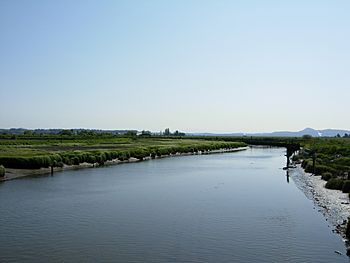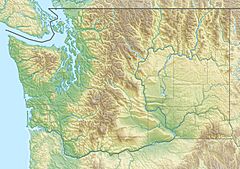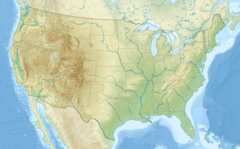Samish River facts for kids
Quick facts for kids Samish River |
|
|---|---|

Samish River near Edison, Washington.
|
|
|
Location of the mouth of the Samish River in Washington
|
|
| Country | United States |
| State | Washington |
| City | Edison, Washington |
| Physical characteristics | |
| Main source | Washington, United States |
| River mouth | Samish Bay Washington, United States 48°33′27″N 122°27′59″W / 48.55750°N 122.46639°W |
| Length | 25 mi (40 km) |
| Basin features | |
| Basin size | 139 sq mi (360 km2) |
| Tributaries |
|
The Samish River is a river about 25 miles (40 km) long. It flows through northwestern Washington in the United States. This river collects water from an area of about 139 square miles (360 km2). This area is located between the Skagit River basin to the south and the Nooksack River basin to the north.
Contents
Where Does the Samish River Start and End?
The Samish River begins in Whatcom County. This is a low area where the land divides. One of its important smaller streams, Friday Creek, starts in the hills south of Bellingham.
The river then flows southwest through Skagit County. Finally, it empties into Samish Bay. Samish Bay is part of Puget Sound, which connects to the Pacific Ocean.
What Fish Live in the Samish River?
The Samish River is a very important home for many types of fish. It is especially known for its large number of King Salmon that return in the fall. These salmon come back to the river to lay their eggs.
Salmon and Trout Species
The Samish River has different types of salmon and trout. These fish use the river for their life cycles.
- Salmon:
- Spring/Winter Steelhead
- Summer Sockeye
- Fall Chinook
- Fall Chum
- Fall Coho
- Trout:
- Cutthroat (found year-round)
- Dolly Varden (found year-round)
Sometimes, Pink Salmon also visit the Samish River. They come in small groups to lay their eggs, even though they are not as common here.
How Do Fish Hatcheries Help the River?
There are two special places called fish hatcheries that help the fish in the Samish River. These hatcheries help to increase the number of fish.
- One hatchery is located in the upper part of the Samish River. It is just below where Friday Creek joins the main river.
- The second hatchery is several miles up Friday Creek itself.
Both hatcheries focus on raising Fall Chinook salmon. They can produce over 10 million young salmon, called smolt, each year. Out of these, about 5,000 to 20,000 adult salmon will return to the river one to five years later. They come back to lay their own eggs, continuing the cycle.



